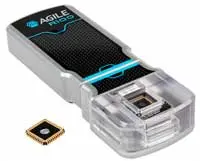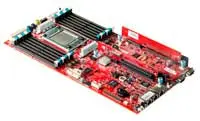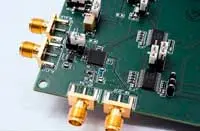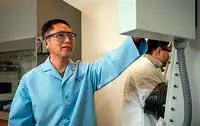Electronics News
Archive : 9 March 2017 год
 US company Nanomedical Diagnostics has worked with MEMS foundry Rogue Valley Microdevices to deliver what is said to be the first mass produced graphene based biosensor.
US company Nanomedical Diagnostics has worked with MEMS foundry Rogue Valley Microdevices to deliver what is said to be the first mass produced graphene based biosensor.
Called the AGILE R100, the benchtop device is designed to provide biophysical data to pharmaceutical and biotherapeutics companies seeking more informed decisions earlier in the drug discovery process.
“Rogue Valley Microdevices has been a true partner in developing a viable large-scale fabrication process for our AGILE biosensor chips,” said Nanomedical Diagnostics’ CEO Ross Bundy. “The ability to manufacture graphene biosensors at scale will enable us to create significant cost reductions for many life science and healthcare applications, as well as introduce game-changing capabilities that have never been seen before.”
The graphene biosensor supports Nanomedical’s Field Effect Biosensing (FEB) technology. FEB is an electrical technique which measures the current across the biosensor in which targets are immobilised. Any interaction or binding that occurs on the surface causes a change in conductance that is monitored in real-time, enabling accurate kinetic, affinity and concentration measurements.
Author
Graham Pitcher
Source: www.newelectronics.co.uk
 Qualcomm Datacenter Technologies (QDT) is working with Microsoft to accelerate next generation cloud services, using its 10nm Centriq 2400 platform. According to the partners, the collaboration will span multiple future generations of hardware, software and systems.
Qualcomm Datacenter Technologies (QDT) is working with Microsoft to accelerate next generation cloud services, using its 10nm Centriq 2400 platform. According to the partners, the collaboration will span multiple future generations of hardware, software and systems.
QDT has also submitted the Centriq 2400 Open Compute Motherboard server to the Open Compute Project (OCP). The specification, based on the latest version of Microsoft’s Project Olympus – a open source cloud hardware design – addresses multiple areas of hardware and software, including board development, firmware, operating system, compilers and tools and CoreCLR security.
The Open Compute Motherboard (pictured) integrates Qualcomm’s 48 core server processor – based on the ARMv8 architecture – with advanced interfaces for memory, network and peripherals. QDT contends this will enable ARM-based servers to be developed for most common cloud compute workloads. The specification fits a standard 1U server system and can be paired with compute accelerators, multi host network interface cards and leading storage technologies.
“Qualcomm is accelerating innovation in datacentres by delivering the world’s first 10nm server processor,” said Anand Chandrasekher, QDT’s general manager. “Our collaboration with Microsoft and contribution to the OCP community enables innovations such as Centriq 2400 to be designed in and deployed into the datacentres rapidly. We are democratising system design and enabling a broad-based ARM server ecosystem.”
QDT added that it has been working with Microsoft for several years on ARM based server enablement. Dr Leendert van Doorn, a Microsoft Distinguished Engineer, added: “Microsoft and QDT are ... addressing server acceleration and memory technologies that have the potential to shape the data centre of tomorrow.”
Author
Graham Pitcher
Source: www.newelectronics.co.uk
 Nanoelectronics research centre imec, along with the Holst Centre, has developed a novel phase-tracking receiver which is said to bring further power and cost reduction for next generation Bluetooth and IEEE802.15.4 chips.
Nanoelectronics research centre imec, along with the Holst Centre, has developed a novel phase-tracking receiver which is said to bring further power and cost reduction for next generation Bluetooth and IEEE802.15.4 chips.
According to the partners, the digital-style receiver is three times smaller than current devices and supports supplies as low as 0.85V, while consuming less than 1.6mW peak. It also features a low power antenna impedance detection technique to enhance radio performance, particularly in wearables or implantable devices.
Imec’s receiver concept is said to consume less than 1nJ/bit, while maintaining an RX sensitivity similar to that of leading devices. Digital phase-tracking translates the RF input directly to demodulated digital data, while digitally controlled oscillator is used instead of a phase locked loop. The receiver, implemented in 40nm CMOS, occupies 0.3mm2, is claimed to allow cost efficient manufacturing.
An integrated, sub mW impedance detection technique for ultra-low power radios enables tunable matching between the antenna and the radio front-end. This approach can be implemented in an adaptive radio front-end to improve receiver sensitivity and transmitter efficiency in the presence of antenna impedance variations.
“This innovative receiver concept will not only serve the new Bluetooth 5 devices, but also provide our industrial partners with a long term competitive advantage for multiple new generations of Bluetooth and 802.15.4 radios,” said Kathleen Philips, director of the imec/Holst Centre Perceptive Systems programme. “This achievement is a confirmation of our continuous efforts to push the technology limits toward ever higher performance, lower power consumption and smaller form factor, which are essential features for IoT radio solutions.”
Author
Graham Pitcher
Source: www.newelectronics.co.uk
 Lithium-sulphur batteries show promise for high energy storage applications according to researchers from the University of Delaware.
Lithium-sulphur batteries show promise for high energy storage applications according to researchers from the University of Delaware.
The energy density of Li-S batteries is said to be five times higher than that of Li-ion batteries, which combined with low cost, put it at a significant advantage.
Li-S batteries are limited by rapid capacity fade, however, which means that the amount of charge these batteries can deliver at the rated voltage decreases significantly with use.
According to the Delaware team, this problem stems from a phenomenon known as the polysulphide shuttle effect, in which the spontaneous formation of polysulphides inhibits performance.
To solve this issue, the team demonstrated a polysulphide entrapping strategy that is said to improve the cycle stability of Li-S batteries.
The researchers claim the addition of ferroelectric nanoparticles into the battery cathode anchors the polysulphides, preventing them from dissolving and causing the loss of active materials at the cathode.
"While the mechanism underlying the trapping of polysulphides is unclear at this point, we're optimistic about the potential of this approach to high performance lithium-sulphur battery applications, as it not only solves the problem of the polysulphide shuttle effect but also can be coupled to current industrial battery manufacturing processes," said Delaware Professor Bingqing Wei.
Author
Peggy Lee
Source: www.newelectronics.co.uk
 Bubbles that form on a heated surface have been shown to create a tiny recoil which could be used to cool high power microelectronics in space and other applications, according to researchers at the University of Illinois at Chicago (UIC), under funding from NASA.
Bubbles that form on a heated surface have been shown to create a tiny recoil which could be used to cool high power microelectronics in space and other applications, according to researchers at the University of Illinois at Chicago (UIC), under funding from NASA.
"In flights to Mars or the moon, equipment like computers generate a lot of heat," said UIC Professor Alexander Yarin.
Engineers have looked to ‘pool-boiling’, which is liquid-cooling at a temperature near the boiling point of the fluid. In boiling, all heat is absorbed in converting the liquid to vapour, with no further rise in temperature until the phase change is complete.
But the lack of gravity in space poses a problem for pool-boiling as the bubbles have no buoyancy.
"On Earth, the bubbles rise, and cold coolant comes in," Prof Yarin said. "But in space, the bubbles don't rise. They stay on the submerged surface, and can merge together to form an insulating vapour layer, and the heat-removal process is interrupted.
"You can try mechanical mixing, but a motor also creates heat. You can try a strong electric field, but that also produces heat and creates other problems," he said. Both methods take up space and require power.
Looking to solve the problem, the team sandwiched two heat-generating chips back to back. By alternating the voltage between the two chips, they caused the apparatus to swing back and forth through the coolant at 1cm/s.
"When one chip operates, it produces bubbles and a recoil force, and it pushes back enough to swing the chips in the cooling fluid and shed the bubbles," Prof Yarin explained. "It works with or without gravity – in space, exactly as on Earth."
Author
Peggy Lee
Source: www.newelectronics.co.uk
